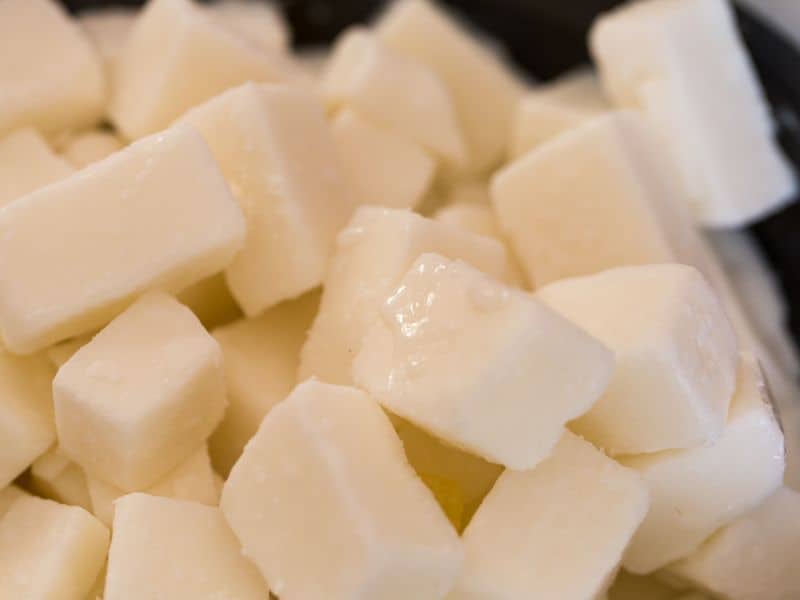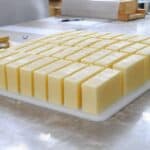Are you making melt and pour soap at home but finding the finished product to be rubbery? If so, then you’re not alone. Fortunately, there are a few simple techniques that can help you get better results. In this article, we will discuss what causes soap to become rubbery and how to fix it.
Melt and pour soap can become rubbery due to overheating during the melting process, using too many liquid additives or fragrances, using old or expired soap base, or storing the soap improperly.
Some of these issues can be prevented if you identify the cause, and some of them can even be fixed if you understand what went wrong. Let’s take a closer look at some of the issues that cause rubbery melt and pour soap and what you can do to rectify the situation.
Common Reasons for Rubbery Melt and Pour Soap
Even experienced soap makers can sometimes run into the issue of rubberiness in their final product. Rubberiness refers to a soap that has a rubber-like texture, making it difficult to lather or use effectively.
Overheating during the melting process
One of the primary causes of rubberiness in melt and pour soap is overheating during the melting process. It’s important to melt the soap base slowly and at a low temperature to avoid overcooking it. Overheating the soap can cause the additives to break down, resulting in a rubbery texture.
Adding too much liquid additives
Adding too many liquid additives, such as oils or glycerin, can also contribute to rubberiness in melt and pour soap. While these additives can provide moisturizing benefits to the soap, adding too much can interfere with the soap’s structure and texture.
Using too much fragrance or essential oil
Similarly, using too much fragrance or essential oil can also result in rubberiness. Fragrance and essential oils can affect the texture of the soap if they’re added in excess or if they’re not properly incorporated into the base.
Using old or expired soap base
Finally, using old or expired soap base can lead to rubberiness in the finished product. Soap base has a shelf life and can break down over time, resulting in a rubbery or grainy texture.
Effects of Rubberiness on Melt and Pour Soap
Rubberiness in melt and pour soap can have several negative effects on the finished product.
Changes in texture and appearance
A rubbery soap may have a dull, matte finish instead of the shiny, translucent appearance that’s typical of melt and pour soap. Additionally, rubbery soap can feel slimy or sticky to the touch, making it unpleasant to use.
Difficulties with cutting and molding
When the soap is rubbery, it can be challenging to achieve clean, even cuts, and the soap may not release from the mold properly. This can result in an uneven, unattractive finished product that may not meet the maker’s expectations.
Shorter shelf life
When the soap has an altered texture, it may not be as stable or long-lasting as a properly made soap. The rubbery texture can lead to the soap breaking down or developing mold or other issues, shortening its overall shelf life.
How to Prevent Rubberiness in Melt and Pour Soap
Fortunately, there are several steps that can be taken to prevent rubberiness and ensure a smooth, high-quality finished product.
Avoid overheating during melting process
Avoid overheating the soap base during the melting process. Overheating can cause the soap to break down and become rubbery, so it’s important to melt the soap slowly and at a low temperature. It’s also important to use a double boiler or another gentle heating method to avoid scorching the soap.
Use only recommended amounts of liquid additives and fragrances
Use only the recommended amounts of liquid additives and fragrances. While these additives can provide moisturizing benefits and pleasant scents, adding too much can affect the texture of the soap and lead to rubberiness. It’s best to measure these ingredients carefully and follow the manufacturer’s instructions closely.
Check the expiration date on soap base
Checking the expiration date on the soap base is another important step in preventing rubberiness. Soap base can have a shelf life, and using old or expired soap can lead to a rubbery or grainy texture in the finished product. Be sure to check the expiration date on the packaging and use fresh soap base whenever possible.
Properly store melt and pour soap
Properly storing melt and pour soap is also essential for preventing rubberiness. It’s important to keep the soap in an airtight container in a cool, dry place, away from direct sunlight or sources of heat. Exposure to heat or moisture can cause the soap to break down and become rubbery.
Solutions for Rubbery Melt and Pour Soap
Rubbery melt and pour soap can be frustrating for soap makers, but fortunately, there are several solutions to salvage the soap and make it usable.
Remelt and add more soap base
One option is to remelt the rubbery soap and add more soap base to it. This can help to restore the soap’s texture and make it usable again. Simply melt the soap base as usual, then add the rubbery soap to the melted base, stirring until it’s fully incorporated.
Be sure to melt the soap base slowly and at a low temperature to avoid overheating the soap and causing it to become rubbery again.
Turn the soap into liquid soap
Turning the rubbery soap into liquid soap is another option. This can be done by grating the soap and mixing it with hot water, glycerin, or other liquid soap-making ingredients. The mixture can then be heated and blended until it reaches a smooth, liquid consistency.
Use the soap as a body wash
The rubbery soap can also be used as a body wash. While it may not be suitable for use as a bar soap, it can still provide cleansing benefits when used as a liquid soap. Simply dissolve the grated soap in hot water and mix it with other liquid soap-making ingredients to create a body wash that’s gentle on the skin.
By exploring these solutions, soap makers can salvage their rubbery melt and pour soap and turn it into a usable product that can still provide the benefits of handmade soap-making.
Frequently Asked Questions
Rubberiness in melt and pour soap can be prevented by avoiding overheating during melting, using recommended amounts of additives and fragrances, checking expiration dates on soap base, and storing the soap properly.
Rubbery soap can be salvaged by remelting and adding more soap base, using it as a shaving soap, turning it into liquid soap, or using it as a body wash.
Rubbery soap can have changes in texture and appearance, be difficult to cut and mold, and have a shorter shelf life.
Rubbery soap may not be suitable for use as a bar soap, but it can still be used as a shaving soap, liquid soap, or body wash.
Conclusion
In conclusion, rubberiness can be an issue for soap makers who use melt and pour soap, but there are several ways to prevent it from occurring and also salvage rubbery soap. By following the tips outlined in this article, soap makers can enjoy a smoother, more consistent finished product that will last longer and provide the desired benefits of handmade soap-making. With proper care and attention, soap makers can create beautiful, lasting products that their customers will love.






